The concept of cooking meat on an open fire likely started in prehistoric times. While that may be at the heart of the rich BBQ tradition, in the United States, the idea of BBQ is intimately associated with sauce. BBQ sauce recipes are among the most treasured secrets of restaurants and grill masters throughout the country. And regional variations in the makeup of sauce recipes are what give way to the age-old debate about where BBQ is best.
While many different versions of BBQ sauce exist – each rooted deeply in its own regional tradition – I think that almost all of these sauces can be reduced to a simple formula. And once you are aware of this formula, constructing your own special BBQ sauce is a breeze! It can actually be very fun to concoct new BBQ sauces at home, and you can get pretty unusual with choices of ingredients (balsamic vinegar? coffee? Scotch? It’s all here!).
So, here’s the formula for making BBQ sauce: Sweet + Tangy + Sticky + X. Okay, it doesn’t sound so revolutionary now (and what is X? – no worries, I’ll get there in a moment). But if we think about what the function of each element is in a BBQ sauce, the way to create original recipes using many different ingredients becomes clear.
The sweet, which would typically come from sugars or honey, is the main flavoring constituent and it provides the meat with that BBQ sheen. BBQ sauces can be varying degrees of sweet, but (almost) all have some sweetness to offset the next element of tangy.
Tangy usually comes from vinegar-based additions such as mustard or vinegar itself. It serves multiple purposes, the most obvious of which is to create that specific flavor profile we all associate with BBQ sauce. It also provides a vehicle that will allow flavor to permeate meat, because vinegar is acidic and can break down protein structure allowing deeper penetration of spices and flavoring agents. Finally, vinegar is an anti-microbial agent. In the early days of BBQ, one key function of the sauce was to help preserve the meat, and vinegar helped in this regard.
The stickiness of a BBQ sauce is important because it controls how well the sauce adheres to the meat. Sweetening agents play an additional role in this facet, as caramelized sugar and honey can be used to enhance stickiness. Molasses can also be added to give additional stickiness while not contributing as heavily to the sweetness of the recipe. The sticky factor is one of the most variable in traditional BBQ sauces, as some tend to rely more on penetration of the meat to provide flavor. However, these days, the popularity of super-sticky sauces such as the ones famous in Kansas City have led to most BBQ being served with at least a sticky tableside sauce for finishing.
Lastly, there is the “x.” This is what makes recipes secret. Spice blends and other wild card ingredients can totally alter the overall taste of a sauce, and this is what sets them apart the most when we eat them. Smoky, spicy hot, and other flavors can be added with just a few transformative ingredients. In other word, when you are making your own sauce at home, “x” is the creativity and ingenuity factor!
Let’s take a look at some of the famous BBQ traditions in the United States and the sauces associated with them.
When the majority of people think about BBQ sauce, they think about the sweet and sticky red sauce that is bottled and shelved next to ketchup at the grocery store. It turns out that these mass produced sauces are most closely related to the Kansas City Style. KC-style sauces are strongly ketchup-based. Ketchup as an ingredient falls in both the sweet and tangy categories (it being made up itself of tomatoes, sugar, and vinegar). The ketchup dictates the strong red color of the sauce, but it is augmented by the additions of yellow mustard (tangy), honey (sweet, sticky), molasses (sticky, somewhat sweet), and brown sugar (sweet). As you might predict, KC-style sauces are among the sweetest and stickiest along the spectrum. They don’t have as much tang, and they also tend not to be incredibly penetrative (they sit on top of the meat like a glaze). KC-style sauces are commonly flavored with liquid smoke and/or chili powder (i.e. the “x” ingredients) to generate a distinctive smokiness.
The Carolinas may very well be where the BBQ sauce tradition all started in the US. As early sauces were meant as preservatives, Carolina sauces tend to be heavier on the tangy ingredients. Within the Carolinas there are several notable variations. Along the coast, the “mop-sauce” is the most popular. Mop sauce is so named because it is “mopped” along the meat as it cooks. It tends to be low on sweetness, with only small amounts or no white sugar added. The scant amount of sugar also acts as the only element of stickiness, as it caramelizes on the outside of the meat over the heat. For tangy, mop sauce skips the mustard and its flavors and just uses straight white vinegar. Black pepper and red pepper are added as flavoring agents. Away from the coast in North Carolina, ketchup is added to the mop sauce providing extra sweetness and body.
Western South Carolina uses an entirely different approach. While many BBQ sauces make use of mustard as a secondary agent of tangy, in South Carolina it is used as a base. No ketchup is used, so these BBQ sauces are bright yellow. Cider vinegar and small amounts of tomato paste provide additional tang and a minimal amount of sweetness. White sugar is used as the main sweetener, and again its caramelization is depended on for stickiness. A myriad of x-type ingredients are used including onions, garlic, black pepper, hot sauce, and herbs making SC-style BBQ sauce extremely flavorful.
Another famous BBQ locale is of course the Lone Star State. Texas BBQ is reputed for being very different in terms of flavor profile. Like the coastal Carolina versions, Texas BBQ sauce is used more for penetration than glazing. More unique to Texas sauces is the use of beef drippings. While in Carolina BBQ means pork, Texas is most famous for its beef brisket. And because brisket cooks anywhere from 12 hours to overnight, there are plenty of flavorful drippings to incorporate into the Texas BBQ sauce. In Texas, BBQ sauce also tends to incorporate more black pepper, cumin, and onion. Minimal amounts of ketchup or tomato paste provide some body and sweetness, and vinegar is used for tanginess. These sauces are the least sticky out there, but because of the use of meat drippings, the flavor stays on the meat very effectively.
In Tennessee, we are brought back to the thicker and stickier BBQ sauces. While similar to the KC-style sauces, there are a number of things that set Tennessee sauces apart. They tend to have a much “heavier” flavor profile, making more use of dark molasses rather than honey for sticky and sweet (they often eschew any type of sugar altogether). Malt vinegar is also used in place of white vinegar, giving a unique essence. Ketchup is used but not as liberally, and it is not the main flavor constituent as in KC sauces. Another interesting feature in some Tennessee sauces is the addition of whiskey. Both Jack Daniel’s and Bourbon are utilized, and these add sweetness and other flavor notes to the sauce.
Big Bob Gibson’s Bar-B-Q in Alabama has introduced a white BBQ sauce that they recommend for Chicken. It uses Mayonnaise as a base (tangy), and while the actual recipe isn’t known, those who have tasted it suggest that it also contains cider vinegar, apple juice (sweet), lemon juice, horseradish, mustard powder, and spices. I will admit to never trying white BBQ sauce of any kind, but it seems to be fairly popular and gaining repute around the BBQ world.
Many other BBQ sauces exist, and even within the regions I’ve profiled there must be dozens of variations between restaurants and private chefs. Part of the fun in BBQ sauce formulation is trying things out and seeing what you like. Hopefully my “formula” serves as inspiration to try out some interesting things in your kitchen, even if it is a bit simplistic in nature. If you’re still looking for starting points or even some suggestions for recipes, I’ve listed a few that we prepared the other day to compare. For meats, we used chicken breast, pulled pork, and beef back ribs. Since I wanted to sample a bunch of sauces with these, I didn’t cook them all in sauce. However, I did dry-rub them, so that they were flavorful on their own and I could just use the sauces for finishing tableside.
Recipes:
Sweet Chipotle
- 2/3 cup ketchup
- ¼ cup yellow mustard
- ¾ cup honey
- 2 tsp cumin
- 1 chipotle pepper in adobo sauce, chopped
- 1 tsp adobo sauce
- 2 tsp Worcestershire sauce
- 1 tbsp granulated garlic
- 2 tbsp white sugar
- 1 tbsp light brown sugar
In saucepan over medium, mix all ingredients. Stir until smooth and all sugars dissolved. Allow to come to a boil before removing from heat.
This is a very basic sauce, and I use it most often of all the recipes here. It’s quick and all of the ingredients are standard in my pantry. It is versatile and can be used as a glaze or a simmering sauce. With a little water, you could even braise in it.
Maple Balsamic
- 3 tbsp tomato paste
- 3 tbsp Dijon mustard
- ¼ cup dark brown sugar
- ½ cup water
- 2 tbsp maple syrup
- 2 tbsp balsamic vinegar
Dissolve the tomato paste in the water over the heat. Add the mustard and sugar and stir until combined. Allow to come to a boil. Remove from heat and add the syrup and vinegar.
This was Tricia’s favorite of all the sauces. It is different, but it still tastes very BBQ in spirit. It’s a darker, almost black sauce, and it works really well with chicken and pork.
BBQ’ed Dumpling Sauce
- 1 tbsp canola oil
- 1 tbsp garlic, minced
- 1 tbsp ginger, minced
- 6 tbsp Sriracha
- ¼ cup white sugar
- 1 tbsp Dijon mustard
- 2 tbsp honey
- 2 tbsp black vinegar
- 2 tbsp white vinegar
- 3 tbsp sugar
- 4 tbsp black bean sauce
Heat the oil over medium high in a saucepan. When shimmering, and the garlic and ginger, cooking until fragrant. Add the sugar, Sriracha, mustard and honey. Combine the mixture until smooth. Add the black bean sauce and allow everything to come to a boil. Finish by adding the vinegars.
This sauce is especially spicy. As the name suggests, it goes well with dumplings, but it can also be paired very well with pork, especially ribs of any kind.
Molasses Joe
- 2 cups coffee
- 1 cup light brown sugar
- 1 tbsp butter
- 1 tsp ginger
- 2 tbsp white sugar
- ¼ cup molasses
- 1 tsp chili powder
- 1 tsp coriander powder
- 1 tsp cumin powder
- ½ cup apple cider vinegar
Brew extra strong coffee (I suggest espresso or French Press). Take 2 cups of coffee and add to sauce pan. Dissolve the light brown sugar in the coffee. Allow this mixture to boil and reduce to 1 cup. Set aside.
In another sauce pan, melt the butter. When it’s hot, fry the ginger until fragrant. Next add the sugar, chili powder, coriander, and cumin. After about 1 minute, add the coffee syrup back in. Allow the whole thing to come to a boil. Now add the molasses and apple cider vinegar. Allow to reduce to desired consistency and serve.
This sauce turned out very dark and sticky. The bitterness of the coffee is echoed by the molasses. It goes very well beef ribs and it punched up the chicken breast quite a bit.
Sweet onion mustard
- 1 tbsp butter
- 1 tsp canola oil
- ½ sweet onion, chopped
- Juice ½ lemon
- 1 cup yellow mustard
- 1 tbsp light brown sugar
- 1 tbsp white sugar
- 1 tbsp hot sauce
- 1 tsp mustard powder
- ½ tbsp cracked pepper
Heat the butter and oil over medium high. When hot, add the onion and allow to just caramelize. Deglaze pan with lemon juice. Add the rest of the ingredients and combine until homogeneous. Use and immersion blender to puree the chopped onions for a smooth sauce.
This was very similar to the South Carolina style BBQ sauce. It was tangy and very different. It is more like a paint than a sauce in some ways, but I liked it on the chicken the best. I think it would go well with beef too, because its acidity would help cut the fattiness and heaviness of beef.
Smoky red
- 1.5 cups ketchup
- ½ cup white vinegar
- ¼ cup dark brown sugar
- 3 chipotles in adobo, chopped
- 1 tbsp cumin powder
- 1 tbsp paprika
- 2 tsp Worcestershire sauce
- 2 tsp liquid smoke
- 2 tbsp molasses
Combine all the ingredients except the last two over medium heat. When the mixture boils, add the liquid smoke and molasses and stir until smooth.
This is a kicked up KC sauce at heart. The liquid smoke goes a long way, and you really get that hickory flavor. We simmered some pulled pork in this and really liked it.
Laphroaig caramel
- ½ cup white sugar
- 1 tbsp fresh cracked pepper
- 1 shot Laphroaig (Scotch)
- 2 tbsp maple syrup
- 1 cup yellow mustard
Heat the sugar in a saucepan over medium high. Whisk it continuously. After a few minutes, the sugar will begin to clump and caramelize. Keep whisking to prevent burning. Melt until the sugar is smooth and amber in color. Add the Scotch. The caramel will immediately seize, so you must whisk vigorously until it smoothens out again. Add the rest of the ingredient and stir to homogenize.
A note on the Scotch: Laphroaig is a particularly smoky Scotch from the isle of Islay. To those unaccustomed to it, it may not be your favorite thing (some people literally think it tastes like an ashtray [Tricia] – but then again some of us love it! [Siddharth]). For a smoother taste, substitute Bourbon or a lighter scotch such as Balvenie or Glenmorangie.
Despite the warning, Tricia (who hates the smell of my treasured Laphroaig bottle) really enjoyed this. The smokiness paired well with the other flavors, and the alcohol burned away for the most part. The caramelized sugar gave a distinct taste and sweetness that was very unique. This was one of the most versatile sauces, and we found it tasty on everything.


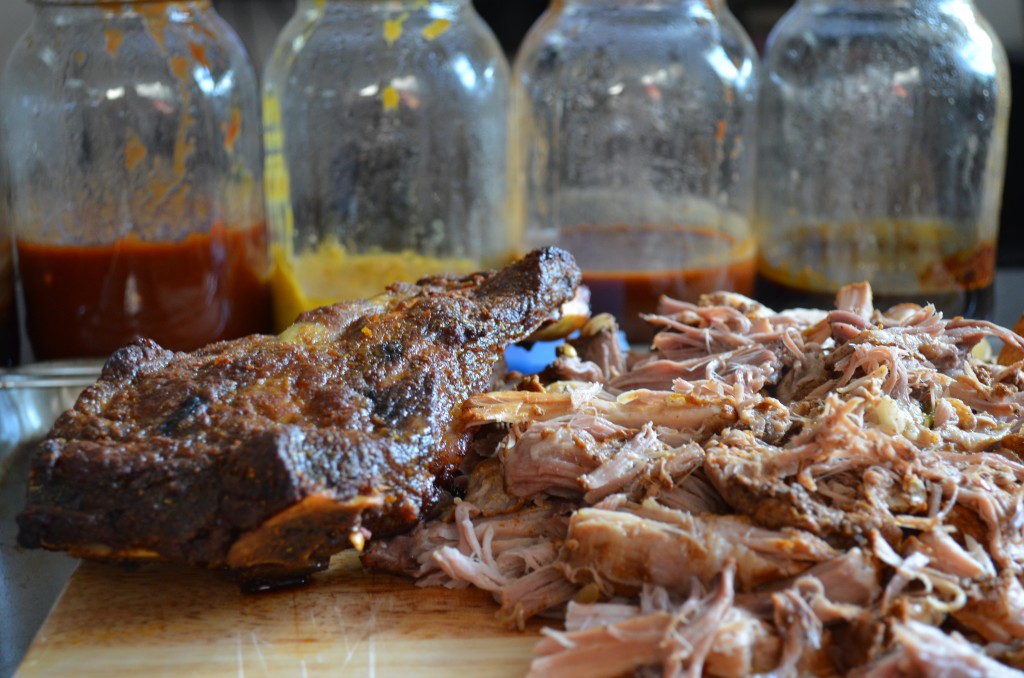
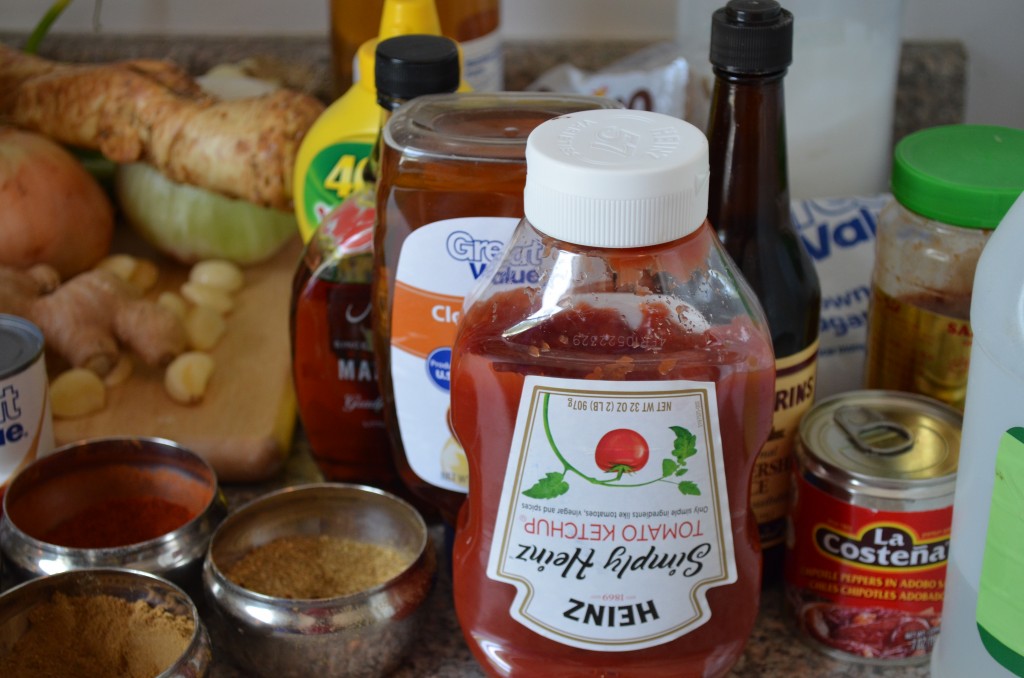
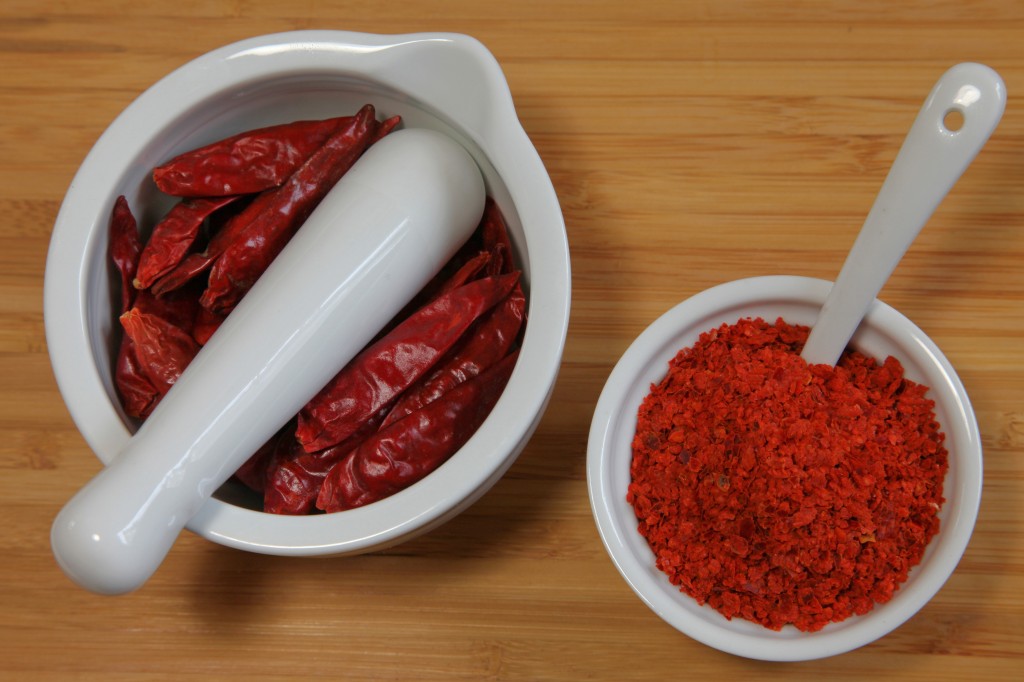

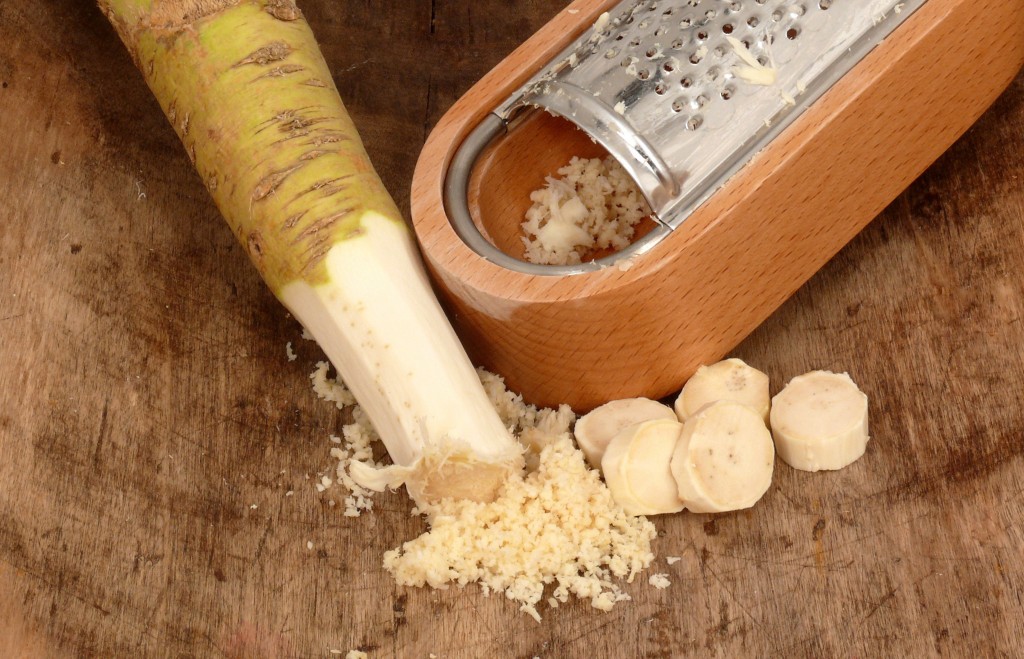
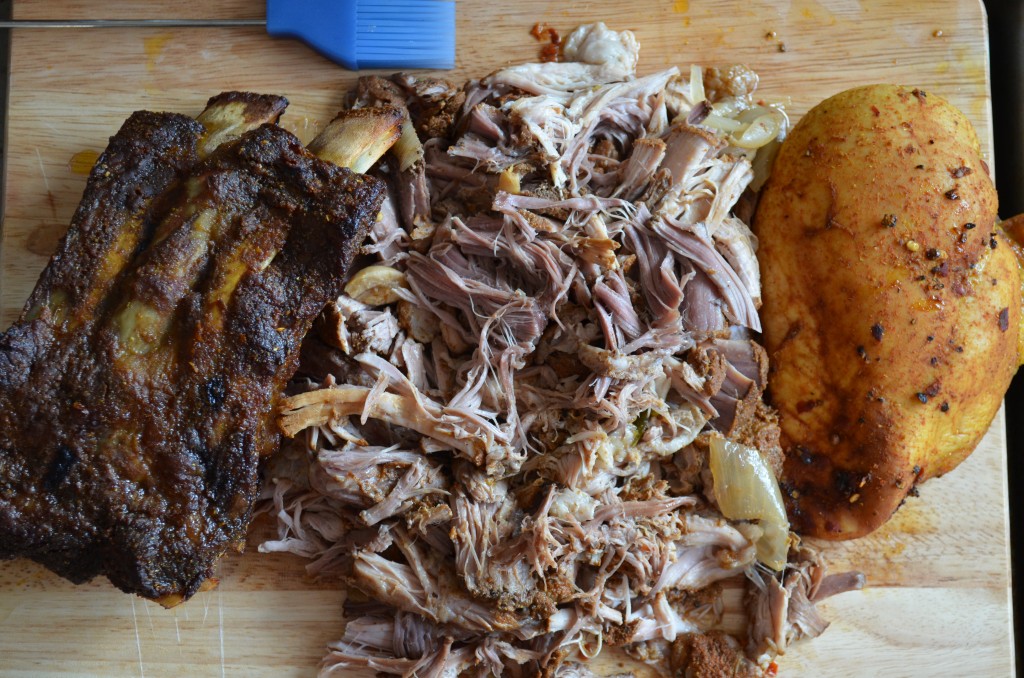
Wow! Great article. Did you have fun preparing all the sauces? which was your favorite?
This type of project is the most fun for me. It’s almost always overkill in terms of quantity! I really liked the taste of all, but the Laphroaig Caramel was the most fun to make. I love making caramel in general, and adding scotch and making a BBQ sauce from it felt very unique.
Liquid smoke or a peaty scotch to add smokiness to your sauce? Seems like overkill, the smoke should come from the BBQ process not from the sauce.
And when’s the post coming on the far more important part of BBQ coming? The Rub!
Layers, layers!
In all honesty, really good BBQ doesn’t even need sauce. But sometimes it’s cold, and you don’t want to go outside to smoke. Or you just made a slow cooked pork roast and your guests like Q-sauce. Either way, a smoky barbecue sauce is just one option.
I agree on the rub, but that’s not a recipe for sharing ;)!